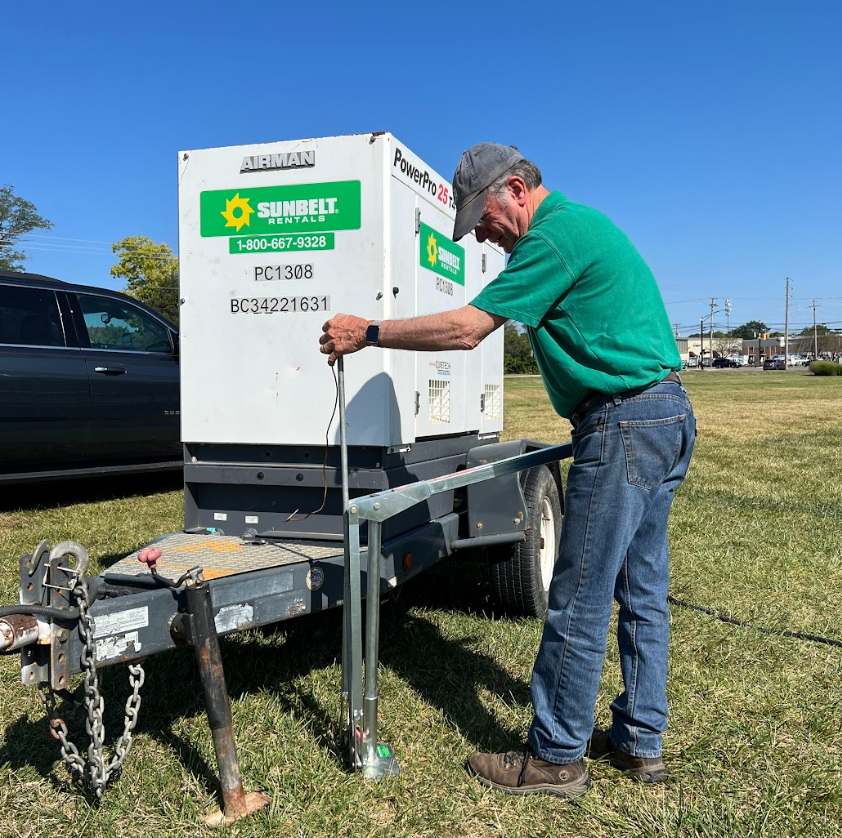Your Cart is Empty
Proudly Made In The USA 🇺🇸
Proudly Made In The USA 🇺🇸
Proudly Made In The USA 🇺🇸

April 25, 2022 3 min read
If you have been in the Tent Rental industry for a while, you probably have seen Pete McVey’s demonstration of the holding power of tent stakes of various sizes and installation configurations. You come away with a better understanding that Mother Nature is not kind to those who do a poor job of staking their tents to the ground. Pete’s bottom line, use big tent stakes (size does matter), drive them straight (vertical) into the ground all the way down, and use more stakes if the ground is soft.
He always ends his demo with a question “How do you know how many stakes to use?” He discusses the IFAI TRD-sponsored study at the University of Illinois. It shows that the number of stakes required is dependent on the soils in which the stakes are placed. Tight soils hold better, soft soils, not so much. The study suggests a method of determining soil tightness and approximating the holding power of the soils. Because the method depends on making “An Average blow with a sledgehammer”, the results are somewhat subjective and subject to wide variations.
After watching Pete’s demo for about four years, it occurred to me that there is a much better way to determine what the holding power of the stakes is in any situation. That is, simply drive test stakes into the ground on the actual job site and pull them out, measure the force required to get them out. Since not every tent rental company has its own tow truck to pull stakes, I made a modification to our JackJaw® Tent Stake Puller that inserted a certified load cell (made by the same company that built the one Pete uses in his demo) that allows the operator to quickly and easily measure the direct force required to pull a stake straight up out of the ground. We introduced the JackJaw® model JJ0313 Stake test in 2012. Since then, many tent rental companies have purchased the unit and made regular use of it to measure and record on their site records the actual holding power of the stakes on each job. Some cities and states are beginning to require this test to prove that the tent was installed properly and can be expected to withstand the forces of Mother Nature (wind). Most of our customers have reported that JackJaw® Stake test has saved their (you know what) on numerous jobs.
The Model JJ0313 uses a very expensive certified load cell and therefore is a little pricey at about $2600. But, how much does a lawsuit cost to defend if your tent comes down in a storm? Can you answer the question a judge will ask you “Did you test the holding power of your stakes on this job?” If you answer “NO”, you may be held negligent which in some states, and this could mean treble damages! No Tent Rental Company wants to risk hurting a tent customer under a collapsed tent or simply enduring the costly loss of a tent.
The largest component of the cost of the JackJaw® JJ0313 is the certified load cell. It is calibrated and can be traced to a national standard. It has been approved by numerous states and the US Army Corp of engineers to make these measurements. It may truly cover your butt legally.
Not everyone needs the JJ0313. But most operators would like to have peace of mind that comes with testing on each job. So, earlier this year, we introduced a new model stake tester that uses a lower cost load cell and provides much of the same Peace of mind. It is called the JJ0314. It sells for $995 with a load Cell! It uses a rugged, electronic load (non-Certified) that will allow you to test holding power up to 2500 lbs.
For more information on the JackJaw line of pullers and testers, contact Bob Anderson at bob@jackjaw.com or call 937-609-8937 or go to the website www.jackjaw.com.

September 19, 2025 3 min read 0 Comments

July 16, 2025 4 min read 0 Comments
Discover why JackJaw® stake pullers are the top choice in construction. Save time, reduce injuries, and remove stakes fast with durable, USA-made tools.
You can easily add text like this to your sidebar to display details about blog authors, upcoming promotions or general info about your shop.
Be the first to know about upcoming sales and promos. Get a 10% discount coupon when you subscribe!